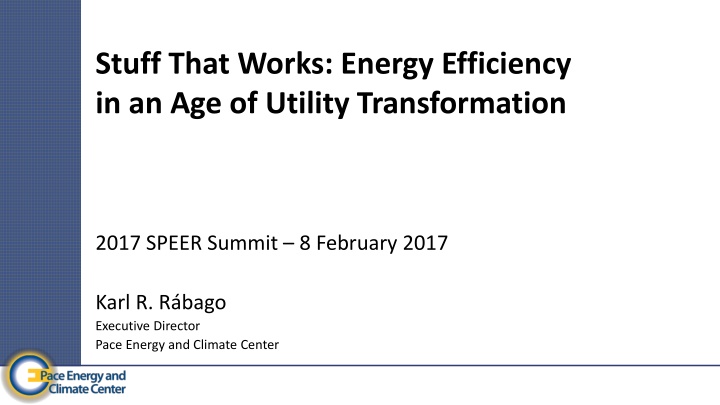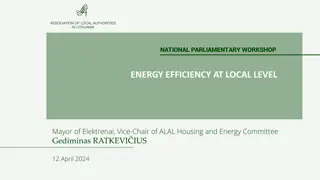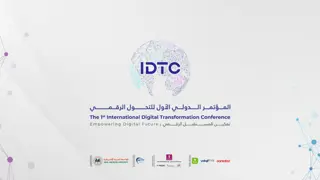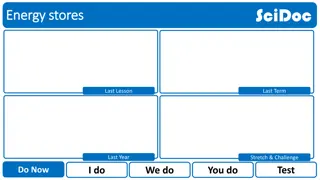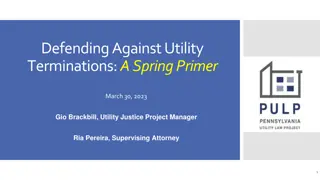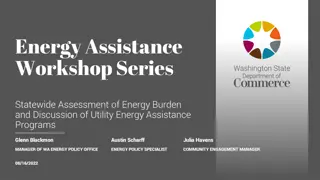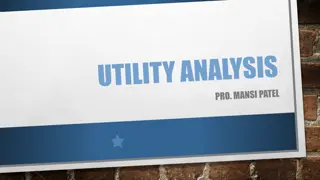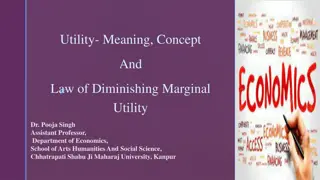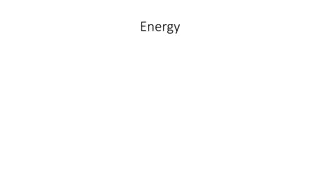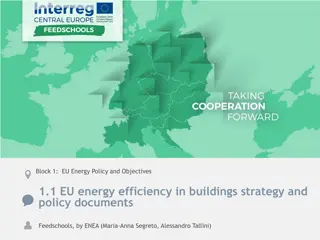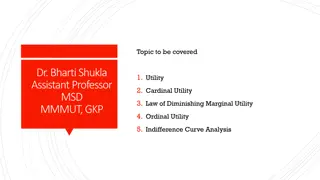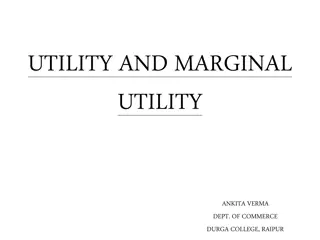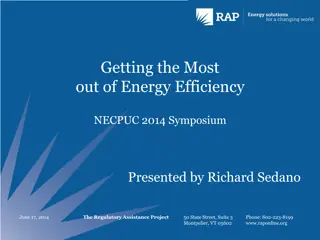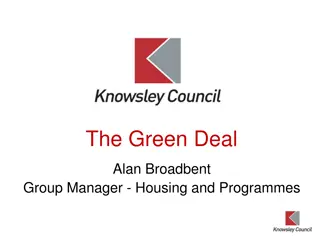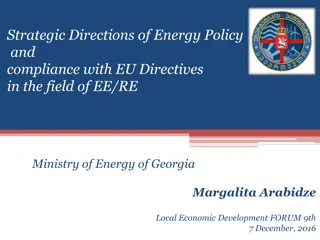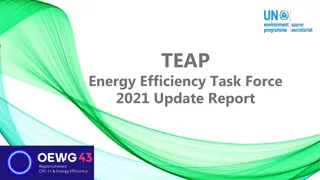Energy Efficiency in an Age of Utility Transformation
Energy efficiency plays a crucial role in the evolving landscape of utility services. The concept of transactive energy and community empowerment is gaining momentum as a means to address climate change. Reforms such as the Energy Vision and Clean Energy Fund Framework are reshaping the industry, emphasizing market-based approaches and valuing system-wide efficiency improvements. This shift towards outcome-oriented metrics and performance incentives is animating energy efficiency markets, driving progress towards clean energy goals.
Download Presentation

Please find below an Image/Link to download the presentation.
The content on the website is provided AS IS for your information and personal use only. It may not be sold, licensed, or shared on other websites without obtaining consent from the author.If you encounter any issues during the download, it is possible that the publisher has removed the file from their server.
You are allowed to download the files provided on this website for personal or commercial use, subject to the condition that they are used lawfully. All files are the property of their respective owners.
The content on the website is provided AS IS for your information and personal use only. It may not be sold, licensed, or shared on other websites without obtaining consent from the author.
E N D
Presentation Transcript
Stuff That Works: Energy Efficiency in an Age of Utility Transformation 2017 SPEER Summit 8 February 2017 Karl R. R bago Executive Director Pace Energy and Climate Center
Utility Transformation The Sharing Utility -- Transactive Energy Bringing real choice and empowerment to small customers, unfinished business since 2001. A technological revolution in scale. An opportunity for utilities, policy makers, and society to escape the throughput trap once and for all. Along with a clean energy standard, the best chance to address climate change. Community is the focal point. R bago Stuff That Works SPEER 2017 2
Reforming the Energy Vision DPS Staff Whitepaper & PSC Order Instituting Proceeding (2014) REV PSC Order Adopting Regulatory Framework & Implementation Plan Track 1 Order (2015) PSC Order Clean Energy Fund Framework CEF Order (1/16) PSC Order Clean Energy Advisory Council CEAC (4/16) PSC Order Ratemaking and Utility Revenue Model Policy Framework Track 2 Order (5/16) PSC Order Clean Energy Standard CES Order (8/16) R bago Stuff That Works SPEER 2017 3
Orbiting Cases, Dockets, Proceedings Benefit Cost Analysis Handbooks Value of Distributed Energy Resources Distribution System Implementation Plans Earnings Adjustment Mechanisms & Scorecards Community Choice Aggregation Community Net Metering Energy Efficiency Transition Plans Low- & Moderate-Income Customer Issues (& Moratorium) Public Interest Transmission Planning Interconnection for Distributed Generation Misc. Pilots & Demonstrations (16 as of now) Rate cases this year (ConEd, Nat. Grid, Cent. Hudson, Orange & Rockland) R bago Stuff That Works SPEER 2017 4
Why Change Our EE Approach? Achieving carbon reduction and clean energy goals would require large increases in existing surcharges. Subsidy programs cannot achieve all that market-based approaches can. Animated markets can attract investment. The regulatory system must begin to properly value the attributes that the SBC has been used to promote. Transition ETIPs Order issued 01/16. R bago Stuff That Works SPEER 2017 5
Animating Energy Efficiency Markets Targets that go beyond the status quo: Clean Energy Fund Energy Efficiency Transition Implementation Plan Targets Outcome-oriented energy efficiency metrics to support utility (distribution company) performance incentives. Measure system-wide efficiency improvements. More lasting market structures beyond SBCs. Input into utility performance incentives implemented through rate filings. Supported by collaborative group outcomes. R bago Stuff That Works SPEER 2017 6
Earnings Adjustment Mechanisms (EAMs) Rewards or penalties; symmetric or asymmetric. To align shareholder interests with desirable system-wide outcomes. Conveyed through specific performance targets. Both a fair and a necessary means of promoting change CEAC charged with developing recommendations on both metrics and targets, and to analyze impacts on peak reduction and load factor. R bago Stuff That Works SPEER 2017 7
Essential Components for EAMs 1. Policy Goals that specify performance areas and desired outcomes. 2. Metrics that provide a standard of measurement for assessing how well the utility is performing in the specified area of interest. 3. Targets that define the level of performance that a utility is expected to achieve during a particular time period, as measured by the metrics. 4. Financial Incentivesthat are based on the utility s performance relative to the target. R bago Stuff That Works SPEER 2017 8
Energy Efficiency Metrics & Target Options CEAC Working Group Report, Matter 16-01006 Report topics: Outcome-oriented metrics Normalization Econometric methodologies Accounting for beneficial electrification Earnings Adjustment Mechanisms Setting and achieving targets System efficiency impacts R bago Stuff That Works SPEER 2017 9
Benefits of Outcome-Oriented Metrics More direct tie of EE to policy objectives. More utility flexibility to pursue innovation. Territory-wide measures reduce program jealousy. EE program managers get credit for creating shareholder wealth. Utility support for and participation in code improvements, code adoption, and stretch codes. Reduction in administrative burdens. R bago Stuff That Works SPEER 2017 10
Risks & Challenges Complex methodological & empirical issues. EE cannot be directly measured; counterfactuals and identification of structural factors required. Shareholder incentives/penalties inspire regulatory contests. Risk of finger-pointing, especially with back-loading. Shareholder/market perception of risk or lack of utility control may dull effectiveness of incentives. Varying perceptions of what constitutes a realistically achievable target. Lack of precedent or cookbooks. R bago Stuff That Works SPEER 2017 11
Outcome-Oriented Metrics for EE Net changes in normalized electricity consumption across the service territory, or Net changes in normalized electricity usage intensity across a sector over time, that are Caused by aggregate EE activities across the territory or sector, including Programmatic and policy interventions, and market- initiated activity. R bago Stuff That Works SPEER 2017 12
Consumption Metrics Reduction in normalized MWh below a PSC-projected baseline level or target level, throughout the service territory. Adjustments for normalization & beneficial electrification. Territory-wide approach risks leaving behind some customers. (Data issues; scorecards; reporting) Wholesale or retail? R bago Stuff That Works SPEER 2017 13
Intensity Metrics Normalized MWh per [indicator of intensity customer, $GDP, etc.] Physical indicators preferred, but data may be lacking. Per meter may not work given variability in conditions, gaming potential. Adjustments to $GDP? Total energy metrics to support deep decarbonization. R bago Stuff That Works SPEER 2017 14
Transition Issues Hybrid path: Ramped-up programmatic investment to achieve policy goals and prevent back-sliding, and Additional opportunity for incentives for exceeding programmatic 100% targets Recent ConEd settlement and upcoming National Grid cases will chart the course. Ramp angles and shapes on the way to the 2030 Clean Energy Standard still to be determined. Analytical tools, such as EEM-specific hourly load impact profiles by segment, and profile aggregation methods still needed. More study, analysis, and data needed. R bago Stuff That Works SPEER 2017 15
Additional Frontiers Non-Wires Alternatives and Demonstration Projects: Brooklyn-Queens Demand Management ( BQDM ) Indian Point Nuclear Plant More granular cost functionalization. Rate-base constituencies for cost functions. Rate of return adjustments by cost function. The future of traditional decoupling. And Business models, blockchain, CCA, CBAs, etc. R bago Stuff That Works SPEER 2017 16
Thank you! Karl R. R bago Executive Director krabago@law.pace.edu 914.422.4082 http://energy.pace.edu
